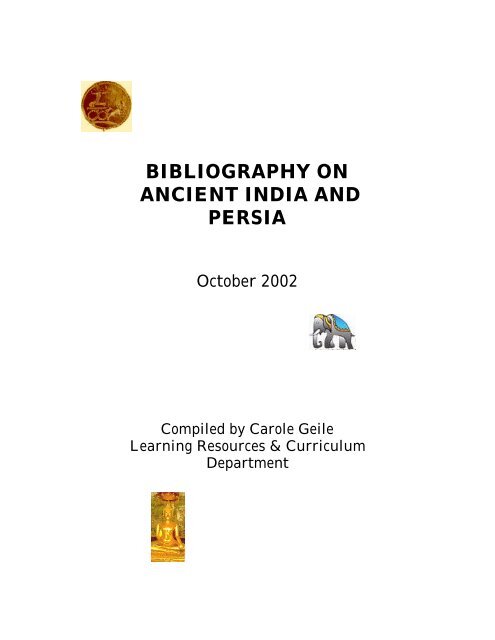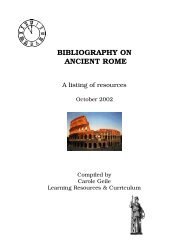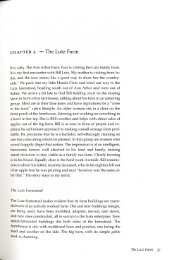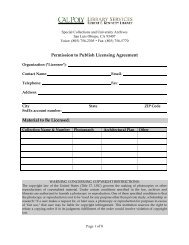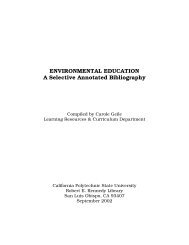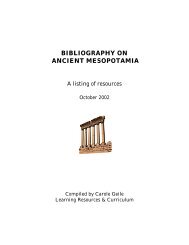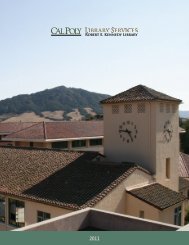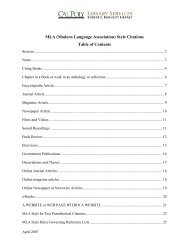Ancient India and Persia
Ancient India and Persia
Ancient India and Persia
Create successful ePaper yourself
Turn your PDF publications into a flip-book with our unique Google optimized e-Paper software.
BIBLIOGRAPHY ON<br />
ANCIENT INDIA AND<br />
PERSIA<br />
October 2002<br />
Compiled by Carole Geile<br />
Learning Resources & Curriculum<br />
Department
ANCIENT INDIA<br />
AND PERSIA<br />
BOOK RESOURCES<br />
Alden, Carella. Royal <strong>Persia</strong>: tales <strong>and</strong> art of Iran. New York: Parents' Magazine<br />
Press, 1972. (WB 955 ALD22R)<br />
Summary: Traces the history of the <strong>Persia</strong>n Empire with emphasis on the art <strong>and</strong><br />
other aspects of its culture.<br />
Bennett, Jill. Folens ideas bank the Indus Valley: a past non-European society.<br />
Dunstable, Engl<strong>and</strong>: Folens, 1995. (WT 300 E/ZBEN IN2V)<br />
Summary: The Indus Valley civilization was one of the world's first great<br />
civilizations. It is thought to have come into existence over 4500 years<br />
ago <strong>and</strong> was at its height between 2500 to 2000 years ago. This book<br />
provides activity pages about the Indus Valley, supported with<br />
background information, extra ideas <strong>and</strong> teaching strategies. Grades 3<br />
<strong>and</strong> up.<br />
Brockett, Eleanor. <strong>Persia</strong>n fairy tales. Chicago, IL: Follett Publishing Company,<br />
1968. (WB 398 BRO782P)<br />
Summary: Presents twenty-five fairy tales of ancient <strong>Persia</strong> about minarets <strong>and</strong><br />
sultans, djinns <strong>and</strong> demons.<br />
Chenevière, Alain. Ramach<strong>and</strong>ra in <strong>India</strong>. Minneapolis, MN: Lerner Publications,<br />
1996. (WB 915.4 CHE42R)<br />
Summary: The story of the young <strong>India</strong>n prince who will one day be maharaja of<br />
Dolapur. Includes information on <strong>India</strong>'s culture, geography, <strong>and</strong><br />
economy. Grades 4-6.<br />
Corwin, Judith Hoffman. Harvest festivals around the world. Parsippany, NJ:<br />
Julian Messner, 1995. (WB 394.2 COR819H2)<br />
Summary: Describes harvest festivals, or rituals to celebrate the gathering of crops,<br />
of people from Asia, Africa, the Middle East, Europe, North America,<br />
<strong>and</strong> the Caribbean. Grades 2-5.<br />
2
Das, Prodeepta. I is for <strong>India</strong>. Parsippany, NJ: Silver Press, 1997. (WB 915.4<br />
DAS26I)<br />
Summary: An alphabetical listing of historical <strong>and</strong> cultural information on <strong>India</strong>.<br />
Forest, Heather. Wisdom tales from around the world: fifty gems of story <strong>and</strong> wisdom<br />
from such diverse traditions as Sufi, Zen, Taoist, Christian, Jewish, Buddhist,<br />
African, <strong>and</strong> Native American. Little Rock, AR: August House Publishers, 1996.<br />
(OVR WB 398 FOR761W4)<br />
Summary: A collection of traditional stories from around the world, reflecting the<br />
cumulative wisdom of Sufi, Zen, Taoist, Buddhist, Jewish, Christian,<br />
African, <strong>and</strong> Native American cultures.<br />
Forest, Heather. Wonder tales from around the world. Little Rock, AR: August<br />
Publishers, 1995. (OVR WB 398 FOR761W6)<br />
Summary: Includes twenty-seven folktales from Europe, Asia, Africa, <strong>India</strong>, the<br />
Arctic, <strong>and</strong> the Americas.<br />
Foster, Genevieve. Augustus Caesar's world: a story of ideas <strong>and</strong> events from B.C. 44<br />
to 14 A.D. New York: Scribner, 1947. (OVR WB 930 FOS81A)<br />
Summary: Parallels comparative religious, social, <strong>and</strong> political forces which<br />
characterized <strong>and</strong> influenced the Roman Empire during the period just<br />
preceding <strong>and</strong> just following the birth of Christ. Examines<br />
contemporary events in Greece, Israel, Egypt, China, <strong>India</strong>, <strong>and</strong> <strong>Persia</strong><br />
as well as Rome.<br />
Ganeri, Anita. Exploration into <strong>India</strong>. New York: New Discovery, 1994. (OVR WB<br />
954 GAN154E)<br />
Summary: Describes <strong>India</strong> from its earliest times through the present. Includes<br />
explorations by Aryans, Chinese, Muslims, <strong>and</strong> Europeans. Grades 5<br />
<strong>and</strong> up.<br />
Ganeri, Anita. <strong>India</strong>. New York: Franklin Watts, 1994. (OVR WB 915.4<br />
GAN154I)<br />
Summary: Describes the civilization of <strong>India</strong> <strong>and</strong> provides instructions for related<br />
craft projects. Grades 5-7.<br />
3
Howard, Dale E. <strong>India</strong>. New York: Children's Press, 1996. (WB 796.0954<br />
HOW832I)<br />
Summary: Discusses recreation in <strong>India</strong>, including yoga, sports, games, folk<br />
dances, <strong>and</strong> kite flying. Grades 4 <strong>and</strong> up.<br />
<strong>India</strong>n gods <strong>and</strong> myths. New York: Chartwell Books, 1999. (WB 294 KIN616I)<br />
Summary: An introduction to the religions <strong>and</strong> myths of the <strong>India</strong>n subcontinent.<br />
Grades 8 <strong>and</strong> up.<br />
Kalman, Bobbie. <strong>India</strong>: the culture. New York: Crabtree Publishing Company, 1990.<br />
(OVR WB 915.4 KAL126I2)<br />
Summary: Describes ancient <strong>and</strong> modern cultures of <strong>India</strong>, including religions,<br />
arts <strong>and</strong> crafts, <strong>and</strong> festivals <strong>and</strong> celebrations. Grades 4 <strong>and</strong> up.<br />
Kalman, Bobbie. <strong>India</strong>: the people. New York: Crabtree Publishing Company, 1990.<br />
(OVR WB 915.4 KAL126I7)<br />
Summary: Covers the people of <strong>India</strong>, including their families, homes,<br />
occupations, <strong>and</strong> languages. Grades 4 <strong>and</strong> up.<br />
Krensky, Stephen. Conqueror <strong>and</strong> hero: the search for Alex<strong>and</strong>er.<br />
Boston, MA: Little, Brown <strong>and</strong> Company, 1981. (OVR WB 921 ALE26K)<br />
Summary: Outlines the life of Alex<strong>and</strong>er, a charismatic individual who was<br />
simultaneously the king of Macedonia, pharaoh of Egypt, <strong>and</strong> emperor<br />
of <strong>Persia</strong>. Grades 6-9.<br />
Lengyel, Emil. Iran. New York: Franklin Watts, 1981. (WB 915.5 LEN547I)<br />
Summary: Discusses the geography, history, cities, customs, <strong>and</strong> culture of this dry<br />
Middle Eastern country formerly called <strong>Persia</strong>. Grades 4-6.<br />
Macdonald, Fiona. Houses: habitats & home life. New York: Franklin Watts, 1994.<br />
(OVR WB 728 MCD145H)<br />
Summary: Describes the history of houses from the Stone Age to efficient<br />
"machines for living" of the future. Grades 5-8.<br />
Millard, Anne. The atlas of ancient worlds. New York: Dorling Kindersley, 1994.<br />
(OVR WB 911 MIL611A)<br />
4
Summary: Explores the history of the ancient world from the Sumerians in 3500<br />
B.C. to the Incas in 1500 A.D. Grades 5 <strong>and</strong> up.<br />
Mollet, David. <strong>Ancient</strong> civilizations. <strong>India</strong>. Torrance, CA: Waldorf Education<br />
Resources, 1994. (WT 300 6ZMOL AN22C46)<br />
Summary: Includes stories which provide an in-depth experience of a particular<br />
time or place. These are designed to be read or “retold” to the class;<br />
they may be duplicated for student use. Also included are dramas for<br />
class or school performance, information sheets presented in an<br />
interesting <strong>and</strong> stimulating format, maps which may be duplicated for<br />
student use, teachers’ guidelines, <strong>and</strong> much more.<br />
Music of ancient civilizations. Eureka, CA: Humboldt County Office of Education,<br />
School/Staff Support Services Department, 1990. (WT 300 E/HUMB M973O)<br />
Summary: Includes instruction <strong>and</strong> the study of songs <strong>and</strong> music on <strong>India</strong>, Egypt,<br />
China, Greece, Rome, <strong>and</strong> Africa.<br />
Nardo, Don. The <strong>Persia</strong>n Empire. San Diego, CA: Lucent Books, 1998. (WB 935.05<br />
NAR166P)<br />
Summary: An account of the rise <strong>and</strong> fall of the <strong>Persia</strong>n Empire, based in part on<br />
archaeological findings of the twentieth century. Grades 5-9.<br />
Rice, Christopher. How children lived. New York: Dorling Kindersley, 1995. (OVR<br />
WB 908.3 RIC36H)<br />
Summary: Describes the lives of 16 children living at different times in history,<br />
e.g., Kuman in <strong>India</strong> 400 years ago <strong>and</strong> Ohe-tika-wi on the Great Plains<br />
of North America 150 years ago. Grades 2 <strong>and</strong> up.<br />
Sarin, Amita Vohra. <strong>India</strong>: an ancient l<strong>and</strong>, a new nation. Minneapolis, MN: Dillon<br />
Press, 1984. (WB 915.4 SAR73I)<br />
Summary: Discusses the people, history, myths <strong>and</strong> legends, worship <strong>and</strong><br />
celebrations, family life <strong>and</strong> food, school life, <strong>and</strong> sports of one of the<br />
world's most populous <strong>and</strong> diverse countries. Grades 6-8.<br />
Schmidt, Jeremy. In the village of the elephants. New York: Walker <strong>and</strong> Company,<br />
1994. (OVR WB 636.967 SCH54I)<br />
5
Summary: The story of Mudumalai, an <strong>India</strong>n elephant, <strong>and</strong> his mahout-intraining,<br />
Bomman. Grades 2-5.<br />
Sharma, Rashmi. A brahmin's castles in the air. Berkeley, CA: Vidya Books, 1994.<br />
(WB 398.05 SHA23B7)<br />
Summary: Adapted from the ancient Panchatantra fables, this is the story of a<br />
young brahmin who preferred to lie back <strong>and</strong> dream his big dreams,<br />
<strong>and</strong> even though he is quite poor in material wealth, he is very rich in<br />
his imagination. Grades K <strong>and</strong> up.<br />
Stewart, Melissa. Science in ancient <strong>India</strong>. New York: Franklin Watts, 1999. (WB<br />
509.34 STE49S)<br />
Summary: An overview of the scientific contributions of ancient <strong>India</strong> including<br />
Arabic numerals, ayurveda, basic chemistry <strong>and</strong> physics, <strong>and</strong> celestial<br />
observations. Grades 4-7.<br />
Sylvester, Diane. <strong>India</strong> <strong>and</strong> China. Torrance, CA: Frank Schaffer Publications,<br />
1997. (OVR WB 930 SYL57I)<br />
Summary: The ancient civilizations of <strong>India</strong> <strong>and</strong> China are two of the oldest on<br />
Earth. Each has made great contributions to the rest of the world in arts<br />
<strong>and</strong> literature, architecture, the sciences, <strong>and</strong> religion. This volume<br />
introduces students to the history, culture, <strong>and</strong> geography of these<br />
ancient civilizations through activities that require them to become<br />
"time travelers" in their quest for knowledge. Grades 4-7.<br />
Tames, Richard. Food: feasts, cooks & kitchens. New York: Franklin Watts, 1994.<br />
(OVR WB 641.3 TAM151F)<br />
Summary: Discusses the history of food from hunting <strong>and</strong> gathering to future<br />
"designer plants". Grades 5-8.<br />
Woods, Michael. <strong>Ancient</strong> construction: from tents to towers. Minneapolis, MN:<br />
Runestone Press, 2000. (WB 624.093 WOO865A)<br />
Summary: Describes buildings <strong>and</strong> structures <strong>and</strong> examines methods <strong>and</strong> tools of<br />
construction in various civilizations around the world, from prehistoric<br />
times up until the end of the Roman Empire. Grades 4 <strong>and</strong> up.<br />
Woods, Michael. <strong>Ancient</strong> medicine: from sorcery to surgery. Minneapolis, MN:<br />
Runestone Press, 2000. (WB 610.901 WOO865A)<br />
6
Summary: Describes medical techniques such as brain surgery, splints, taking a<br />
pulse, forceps, <strong>and</strong> sanitation in ancient civilizations including the<br />
Stone Age, Egypt, Greece, China, <strong>India</strong>, <strong>and</strong> Rome. Grades 4 <strong>and</strong> up.<br />
World history <strong>and</strong> geography: ancient civilizations: course models for the historysocial<br />
science framework, grade 6. Sacramento, CA: California Department of<br />
Education, 1993. (WT 300 6/CALI W893H)<br />
Summary: The study <strong>and</strong> teaching of ancient civilizations.<br />
VIDEOS<br />
Families of <strong>India</strong>. Wilmington, DE: Arden Media Resources, 1995. (Vid C 915.4<br />
F21O)<br />
Summary: Follows a day in the lives of a 9-year-old boy <strong>and</strong> a 6-year-old girl in<br />
Jamnagar, <strong>India</strong>. Grades 1-5.<br />
From bronze to iron. Boston, MA: WGBH Boston, 1989. (Vid C 935 F925B)<br />
Summary: Discusses the collapse of the ancient empires of Assyria Babylonia <strong>and</strong><br />
<strong>Persia</strong> <strong>and</strong> the growth of cities around the Mediterranean; this resulted<br />
in the spread of civilization through war <strong>and</strong> the distribution of booty.<br />
Grades 11 <strong>and</strong> up.<br />
Importers: getting the rugs to market. Wilmington, DE: Teleduction Associates,<br />
1990. (Vid C 382.5 IM73G)<br />
Summary: The ancient <strong>and</strong> modern routes of transport for Oriental rugs are<br />
explored in this episode. Often third or fourth generation rug traders,<br />
the large Manhattan house operators trace their roots back to exporters<br />
<strong>and</strong> agents in <strong>Persia</strong> <strong>and</strong> other weaving countries.<br />
<strong>India</strong>: the empire of the spirit. New York: Ambrose Video Publications, 1992. (Vid<br />
C 954 IN23T)<br />
Summary: Looks at how ancient <strong>India</strong> is with us today in the living tradition of the<br />
Hindu religion, the basis of <strong>India</strong>n culture. Also describes how <strong>India</strong> has<br />
kept true to its ancient tradition of non-violence <strong>and</strong> spiritual search,<br />
even as it became part of the modern world.<br />
7
Origins of <strong>India</strong>'s Hindu civilization. Huntsville, TX: Distributed by Educational<br />
Video Network, 1991. (Vid C 294.5 OR164O)<br />
Summary: Discusses the development of Hinduism, its religious beliefs, <strong>and</strong> its<br />
effect upon the peoples of the <strong>India</strong>n subcontinent. Shows examples of<br />
ancient Hindu art.<br />
PICTURES<br />
<strong>Ancient</strong> civilizations. Madison, WI: Knowledge Unlimited, 1991. (Pic * 930 10755-<br />
64)<br />
Summary: Includes <strong>Ancient</strong> <strong>India</strong>, <strong>Ancient</strong> China, the Egyptians, <strong>and</strong> more.<br />
WEB RESOURCES<br />
“About <strong>Ancient</strong> <strong>India</strong>.” Facts about <strong>Ancient</strong> <strong>India</strong>. 2002.<br />
http://www.spiritualjourneys.net/about_ancient_india.htm (8 October 2002)<br />
Summary: Contains some facts <strong>and</strong> trivia about ancient <strong>India</strong>n civilization.<br />
“<strong>Ancient</strong> <strong>India</strong>.” 1999. http://emuseum.mnsu.edu/prehistory/india/index.shtml (8<br />
October 2002)<br />
Summary: Geography <strong>and</strong> origins of <strong>Ancient</strong> Indus Civilization, cultural elements<br />
<strong>and</strong> timeline of the Harappan, arts technology <strong>and</strong> trade of the classical<br />
Harappan. Grades 6 <strong>and</strong> up.<br />
“<strong>Ancient</strong> <strong>India</strong>.” CyberSleuthKids <strong>Ancient</strong> Civilizations: <strong>India</strong>. 1999-2000.<br />
http://cybersleuth-kids.com/sleuth/History/<strong>Ancient</strong>_Civilizations/<strong>India</strong>/ (8 October<br />
2002)<br />
Summary: Discusses the roots of <strong>India</strong>n civilization, gives information on the<br />
Indus civilization <strong>and</strong> <strong>Ancient</strong> <strong>India</strong>, news on <strong>India</strong>n archeology,<br />
Harappan images, a timeline, peoples <strong>and</strong> languages, <strong>and</strong> much more.<br />
“<strong>Ancient</strong> <strong>India</strong> Contents.” <strong>Ancient</strong> <strong>India</strong>: contents. 1999.<br />
http://www.wsu.edu:8080/~dee/ANCINDIA/ANCINDIA.HTM (7 October 2002)<br />
Summary: Discusses the history, the l<strong>and</strong> <strong>and</strong> peoples, the Aryans, the conquests of<br />
Alex<strong>and</strong>er, the Age of the Guptas <strong>and</strong> after, <strong>and</strong> more.<br />
8
“<strong>Ancient</strong> <strong>India</strong>n Links & Scavenger Hunt.” Bret Harte’s <strong>Ancient</strong> <strong>India</strong> links &<br />
scavenger hunt. 2000.<br />
http://www.sjusd.k12.ca.us/sites/mid/BretHarte/ancient/ancientindia.html (8 October<br />
2002)<br />
Summary: Discover dynasties using an <strong>Ancient</strong> <strong>India</strong> timeline; answer questions<br />
about <strong>Ancient</strong> <strong>India</strong>'s caste system; read tales from Sanskrit dramatists;<br />
do <strong>India</strong>n math puzzles, <strong>and</strong> more.<br />
“<strong>Ancient</strong> <strong>India</strong> Resources.” Ms Hos-McGrane’s grade 6 social studies class. 2002.<br />
http://www.internet-at-work.com/hos_mcgrane/india/eg_india_intro.html (7 October<br />
2002)<br />
Summary: Provides student projects, Web resources, history, art <strong>and</strong> architecture,<br />
culture, religion, literature, <strong>and</strong> <strong>India</strong>n writing.<br />
“<strong>Ancient</strong> <strong>India</strong>’s Contribution to Science <strong>and</strong> Technology.” <strong>Ancient</strong> <strong>India</strong>’s<br />
contribution to our world’s material (temporal) culture. 2002.<br />
http://india.coolatlanta.com/GreatPages/sudheer/physics.html (7 October 2002)<br />
Summary: Learn about ancient <strong>India</strong>ns contributions to mathematics,<br />
shipbuilding, navigation, <strong>and</strong> science.<br />
“Articles on ancient <strong>Persia</strong>.” 1996-2002. http://www.livius.org/persia.html (7 October<br />
2002)<br />
Summary: Includes 118 articles on 99 subjects.<br />
“Cyrus_kourosh.” Cyrus the Great. 1997-1999.<br />
http://www.oznet.net/cyrus/cyframe.htm (8 October 2002)<br />
Summary: Introduces the <strong>Persia</strong>n king believed to be the first to become involved<br />
in human rights.<br />
Donn, Don. “Daily Life in <strong>Ancient</strong> <strong>India</strong>.” 2000.<br />
http://members.aol.com/Donnclass/<strong>India</strong>life.html (7 October 2002)<br />
Summary: This site shares daily life in three major time periods of ancient <strong>India</strong><br />
history; the mysterious Indus Valley Civilization, the Vedic & Epics<br />
Periods, <strong>and</strong> the Age of Empires.<br />
“Harappa: The Indus Valley <strong>and</strong> the Raj of <strong>India</strong> <strong>and</strong> Pakistan.” 1995-2002.<br />
http://www.harappa.com/welcome.html (8 October 2002)<br />
9
Summary: Learn all about life in the Indus Valley. Grades 6 <strong>and</strong> up.<br />
“<strong>India</strong> for Kids.” 2002 Welcome to <strong>India</strong>.<br />
http://home.freeuk.net/elloughton13/india.htm (8 October 2002)<br />
Summary: This section is for children aged 7-9, to give them an insight into the<br />
diverse culture <strong>and</strong> l<strong>and</strong>scape of <strong>India</strong>. For each part there is a 'slide<br />
show', a bedtime story, somewhere to keep 'notes' <strong>and</strong> suggestions for<br />
other web sites to explore.<br />
“<strong>India</strong> – Home.” <strong>Ancient</strong> <strong>India</strong>.<br />
http://www.penncharter.com/Student/india/index.html (8 October 2002)<br />
Summary: Discusses culture, daily life, geography, government, industry, social<br />
levels, <strong>and</strong> more. A grade 6 project.<br />
“<strong>India</strong>: Languages <strong>and</strong> Scripts.” Languages <strong>and</strong> scripts of <strong>India</strong>. 2002.<br />
http://www.cs.colostate.edu/~malaiya/scripts.html (8 October 2002)<br />
Summary: Samples of ancient <strong>India</strong>n inscriptions <strong>and</strong> scripts of many <strong>India</strong>n<br />
languages. Grades 6 <strong>and</strong> up.<br />
“<strong>India</strong>’s Contribution to Physics <strong>and</strong> Chemistry.” <strong>Ancient</strong> <strong>India</strong>’s contribution to<br />
physics <strong>and</strong> chemistry. 2002.<br />
http://india.coolatlanta.com/GreatPages/sudheer/physics.html (7 October 2002)<br />
Summary: Account of the history of these subjects in the subcontinent. Includes<br />
links to other history pages. In <strong>Ancient</strong> <strong>India</strong>, chemistry was called<br />
Rasayan Shastra, Rasa-Vidya, Rasatantra, <strong>and</strong> Rasakriya all of which<br />
roughly mean 'science of liquids'.<br />
“Iransaga – <strong>Persia</strong> or Iran, a brief history.” <strong>Persia</strong> or Iran. 1998. http://www.artarena.com/history.html<br />
(7 October 2002)<br />
Summary: “Most people today, know <strong>Persia</strong> or Iran through its carpets, its caviar,<br />
its costly war with its neighbour Iraq, or through its importance as one<br />
of the world's major oil-producing nations. Yet, <strong>Persia</strong> has one of the<br />
richest <strong>and</strong> oldest cultures in the world”—Web Site.<br />
“Kid Korner-Stories.” INDOlink: Kidz Korner. 2002.<br />
http://www.indolink.com/Kidz/stories.html (8 October 2002)<br />
10
Summary: Stories from ancient <strong>India</strong> like jataka tales, panchatantra. Grades<br />
elementary <strong>and</strong> up.<br />
“Lesson Plan (World History) for teachers about the Indus Valley Civilization.”<br />
Lesson plan – Indus Valley civilization: a social studies/language arts lesson. 1999.<br />
http://members.aol.com/WERedu/Plan<strong>India</strong>.html (7 October 2002)<br />
Summary: The lessons in this unit include geographic background, historic<br />
background, information on seals <strong>and</strong> a craft activity on making seals,<br />
<strong>and</strong> a lesson on deforestation using the Indus Valley for illustration.<br />
“Life in <strong>Ancient</strong> <strong>India</strong> (Lesson Plan).” 2000-2002.<br />
http://www.teachervision.com/lesson-plans/lesson-5222.html (8 October 2002)<br />
Summary: Objectives are for students use vocabulary related to life in <strong>Ancient</strong><br />
<strong>India</strong>, to learn about everyday life in the ancient Indus Valley, to be<br />
able to speculate about what <strong>Ancient</strong> <strong>India</strong>n language might reveal<br />
about its people, <strong>and</strong> to appreciate the contributions of <strong>Ancient</strong> <strong>India</strong> to<br />
our modern world. Grades 6-8.<br />
Mahajan, Nupam. “<strong>India</strong>: A Webpage for the <strong>Ancient</strong> Coins <strong>and</strong> Medieval Coins of<br />
<strong>India</strong>.” Nupam’s Webpage for the <strong>India</strong>n coins. 1999.<br />
http://www.med.unc.edu/~nupam/welcome.html (8 October 2002)<br />
Summary: A study of ancient <strong>and</strong> medieval coins used in ancient <strong>India</strong>.<br />
“Mrs. Wahl’s <strong>Ancient</strong> <strong>India</strong> Links.” Mrs. Wahl’s Web page: <strong>Ancient</strong> <strong>India</strong>. 1999.<br />
http://central.k12.ca.us/akers/cwahl/india.html (7 October 2002)<br />
Summary: Gives an illustrated story of the life of Buddha, Hinduism is simplified<br />
for youths growing up in a western environment, <strong>and</strong> includes a<br />
segment on <strong>India</strong>'s contribution to the world.<br />
“OUSD > Core Values > Unit 3 > <strong>Ancient</strong> <strong>India</strong> > Educational Projects.” Core values<br />
Internet resource library: <strong>Ancient</strong> <strong>India</strong>. 2001-2002.<br />
http://tlc.ousd.k12.ca.us/library/india/india_student.html (7 October 2002)<br />
Summary: This page contains links to websites produced by teachers <strong>and</strong> students.<br />
These include: class projects on ancient <strong>India</strong>, individual student web<br />
projects, <strong>and</strong> curriculum-based activities <strong>and</strong> resources developed by<br />
other teachers. Grade 6.”<br />
11
“<strong>Persia</strong>n Empire.” 1999-2000. http://cybersleuthkids.com/sleuth/History/<strong>Ancient</strong>_Civilizations/<strong>Ancient</strong>_Middle_East/<strong>Persia</strong>n_Empire<br />
/ (8 October 2002)<br />
Summary: Contents include <strong>Ancient</strong> Civilizations clipart, <strong>Ancient</strong> <strong>Persia</strong>, <strong>and</strong> the<br />
<strong>Persia</strong>n Empire.<br />
“Portl<strong>and</strong> State’s Greek Civ for Kids.” Exploring ancient <strong>Persia</strong>. 1997.<br />
http://www.historyforkids.org/greekciv/others/persia/persia2/page.htm (7 October<br />
2002)<br />
Summary: Contents include an introduction, kings, army, law, religion, art, <strong>and</strong> a<br />
conclusion. Middle schoolers.<br />
“The Vedas.” Languages with more than 30,000,000 speakers as of 1993. 1997-2001.<br />
http://www.friesian.com/upan.htm (8 October 2002)<br />
Summary: A summary of languages used in ancient <strong>India</strong>. Includes the numbers of<br />
language speakers <strong>and</strong> migrations as well as information on the Vedas<br />
<strong>and</strong> Upanishads. Grades 6 <strong>and</strong> up.<br />
12


